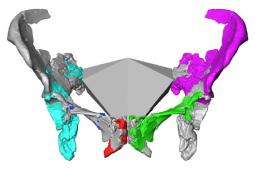'You will give birth in pain': Neanderthals too

(PhysOrg.com) -- Researchers from the University of California at Davis (USA) and the Max Planck Institute for Evolutionary Anthropology in Leipzig (Germany) present a virtual reconstruction of a female Neanderthal pelvis from Tabun (Israel). Although the size of Tabun’s reconstructed birth canal shows that Neanderthal childbirth was about as difficult as in present-day humans, the shape indicates that Neanderthals retained a more primitive birth mechanism than modern humans.
The virtual reconstruction of the pelvis from Tabun is going to be the first of its kind to be available for download on the internet for everyone interested in the evolution of humankind.
Childbirth in humans is more complicated than in other primates. Unlike the situation in great apes, human babies are about the same size as the birth canal, making passage difficult. The birth mechanism, a series of rotations the baby must undergo to successfully navigate its mother’s birth canal, distinguishes humans not only from great apes but also from lesser apes and monkeys.
It has been difficult to trace the evolution of human childbirth because the pelvic skeleton, which forms the margins of the birth canal, tends to survive poorly in the fossil record. Only three fossil female individuals preserve fairly complete birth canals, and they all date to earlier phases of human evolution.
Tim Weaver of the University of California (Davis, USA) and Jean-Jacques Hublin, director at the Max Planck Institute for Evolutionary Anthropology in Leipzig (Germany) now present a virtual reconstruction of a female Neanderthal pelvis from Tabun (Israel). The size of Tabun’s reconstructed birth canal shows that Neanderthal childbirth was about as difficult as in present-day humans. However, its shape indicates that Neanderthals retained a more primitive birth mechanism than modern humans, without rotation of the baby’s body.
A significant shift in childbirth apparently happened quite late in human evolution, during the last 400,000 - 300,000 years. Such a late shift underscores the uniqueness of human childbirth and the divergent evolutionary trajectories of Neanderthals and the lineage leading to present-day humans.
The virtual reconstruction of the pelvis from Tabun is going to be the first of its kind to be available for download on the internet for everyone interested in human evolution. The computer files will be available from the websites of University of California at Davis and the Max Planck Institute for Evolutionary Anthropology.
More information: Timothy D. Weaver, Jean-Jacques Hublin, Neandertal birth canal shape and the evolution of human childbirth, Proceedings of the National Academy of Sciences (PNAS), online Early Edition, April 20th, 2009
Provided by Max Planck Institute


















